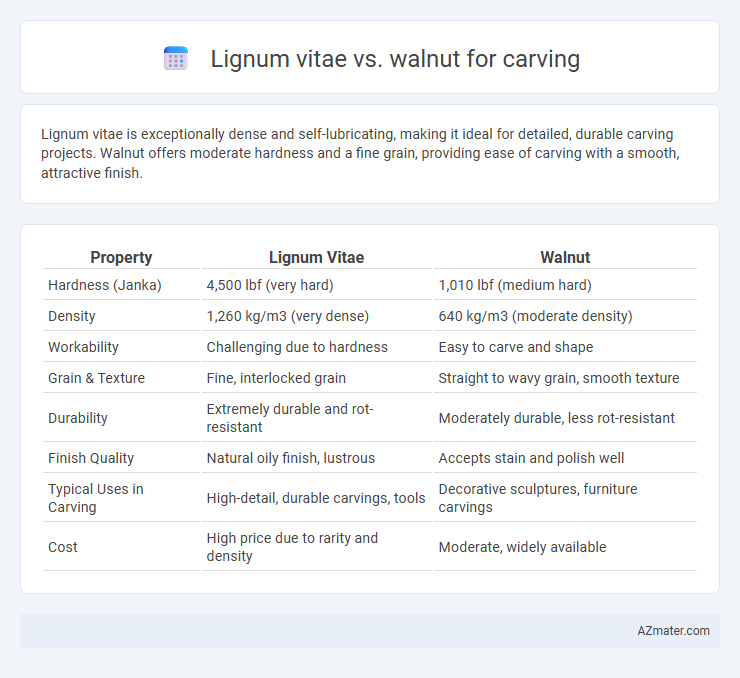Lignum vitae is exceptionally dense and self-lubricating, making it ideal for detailed, durable carving projects. Walnut offers moderate hardness and a fine grain, providing ease of carving with a smooth, attractive finish.
Table of Comparison
| Property | Lignum Vitae | Walnut |
|---|---|---|
| Hardness (Janka) | 4,500 lbf (very hard) | 1,010 lbf (medium hard) |
| Density | 1,260 kg/m3 (very dense) | 640 kg/m3 (moderate density) |
| Workability | Challenging due to hardness | Easy to carve and shape |
| Grain & Texture | Fine, interlocked grain | Straight to wavy grain, smooth texture |
| Durability | Extremely durable and rot-resistant | Moderately durable, less rot-resistant |
| Finish Quality | Natural oily finish, lustrous | Accepts stain and polish well |
| Typical Uses in Carving | High-detail, durable carvings, tools | Decorative sculptures, furniture carvings |
| Cost | High price due to rarity and density | Moderate, widely available |
Introduction to Lignum Vitae and Walnut
Lignum Vitae, known as one of the densest and hardest woods, offers exceptional durability and natural oils that make it highly resistant to wear and decay, ideal for intricate and long-lasting carvings. Walnut wood, prized for its rich brown hues and fine grain, provides moderate hardness combined with excellent workability, making it a popular choice for detailed and smooth woodcarving projects. Both woods serve unique roles in carving, with Lignum Vitae prized for strength and longevity, while Walnut is favored for aesthetic appeal and ease of shaping.
Botanical Background and Origins
Lignum vitae, derived from the Guaiacum genus native to the Caribbean and northern South America, is known for its extreme hardness and natural oils that enhance durability in carving. Walnut, belonging to the Juglans genus mainly found in North America and Europe, offers a moderately hard texture with fine, straight grain ideal for detailed woodworking. Both woods' botanical origins influence their density and workability, making lignum vitae suited for heavy-duty projects and walnut preferred for intricate artistic carvings.
Physical Characteristics Comparison
Lignum vitae features an exceptionally high density of around 1.26 g/cm3, making it one of the hardest and heaviest woods, while walnut has a density ranging from 0.55 to 0.75 g/cm3, offering moderate hardness and weight. Lignum vitae's natural oils contribute to superior durability and a self-lubricating quality ideal for intricate carving, compared to walnut's fine, straight grain that allows for smoother cuts but less resistance to wear. The dark greenish-brown color and tight grain patterns of lignum vitae contrast with walnut's rich chocolate-brown hue and more open grain, influencing aesthetic and textural preferences in wood carving projects.
Workability for Carving Projects
Lignum vitae offers exceptional density and hardness, making it highly durable but challenging to carve, often requiring sharp tools and more effort for detailed work. Walnut is moderately dense with a smooth grain, providing superior workability that allows for precise and intricate carving with less tool resistance. Choosing walnut facilitates easier shaping and finer detail in carving projects, whereas lignum vitae is better suited for items demanding extreme durability.
Durability and Longevity
Lignum vitae is renowned for its exceptional durability and natural oils that provide excellent resistance to moisture, making it ideal for long-lasting wood carving projects. Walnut, while softer and easier to carve, offers moderate durability but lacks the inherent hardness and decay resistance of lignum vitae. For carvings requiring maximum longevity, lignum vitae outperforms walnut due to its density and natural preservation properties.
Color and Grain Patterns
Lignum vitae features a rich, dark greenish-brown color with fine, interlocked grain patterns that create a dense, oily texture ideal for detailed carving. Walnut offers a lighter to deeper brown hue with straight grain and occasional wavy patterns, providing a smooth surface and excellent workability. The contrasting colors and distinctive grain structures of lignum vitae and walnut influence both the aesthetic appeal and carving experience for artisans.
Tool Requirements and Maintenance
Lignum vitae, known for its extreme hardness and natural oils, demands robust, high-quality steel tools capable of retaining sharpness under intense pressure during carving, while Walnut's softer, less dense nature allows for easier cutting with standard carving tools. Tools used on Lignum vitae require frequent sharpening due to its abrasive grain, and maintenance involves cleaning off resinous oils to prevent tool corrosion. In contrast, Walnut's lower resin content and moderate hardness result in less frequent tool maintenance and simpler upkeep for sustained carving precision.
Suitability for Intricate Designs
Lignum vitae, renowned for its extreme density and natural oils, offers exceptional durability and a smooth finish, making it ideal for intricate carving that requires fine detail and long-lasting precision. Walnut, while softer and easier to carve, provides a balanced combination of strength and workability, suitable for detailed designs but less resistant to wear over time compared to lignum vitae. Carvers seeking fine, elaborate patterns that maintain sharpness and clarity in demanding applications often prefer lignum vitae for its superior hardness and natural polish.
Cost and Availability
Lignum vitae is significantly more expensive and less readily available than walnut due to its slow growth and limited harvesting regions, primarily in the Caribbean and Central America. Walnut, widely grown in North America and Europe, is more affordable and easier to source, making it a popular choice for woodcarvers seeking cost-effective materials. The high density and hardness of lignum vitae also contribute to its premium price compared to the more moderately priced and accessible walnut wood.
Final Verdict: Choosing the Best Wood for Carving
Lignum vitae offers unmatched density and natural oils, making it extremely durable, resistant to wear, and perfect for fine, detailed carving that requires strength and longevity. Walnut is favored for its moderate hardness, ease of carving, and attractive grain patterns, making it ideal for both beginners and intricate decorative projects. Choosing between the two depends on the project's durability requirements and aesthetic preferences, with lignum vitae suited for heavy-use items and walnut excelling in decorative, display-focused carvings.

Infographic: Lignum vitae vs Walnut for Carving
 azmater.com
azmater.com